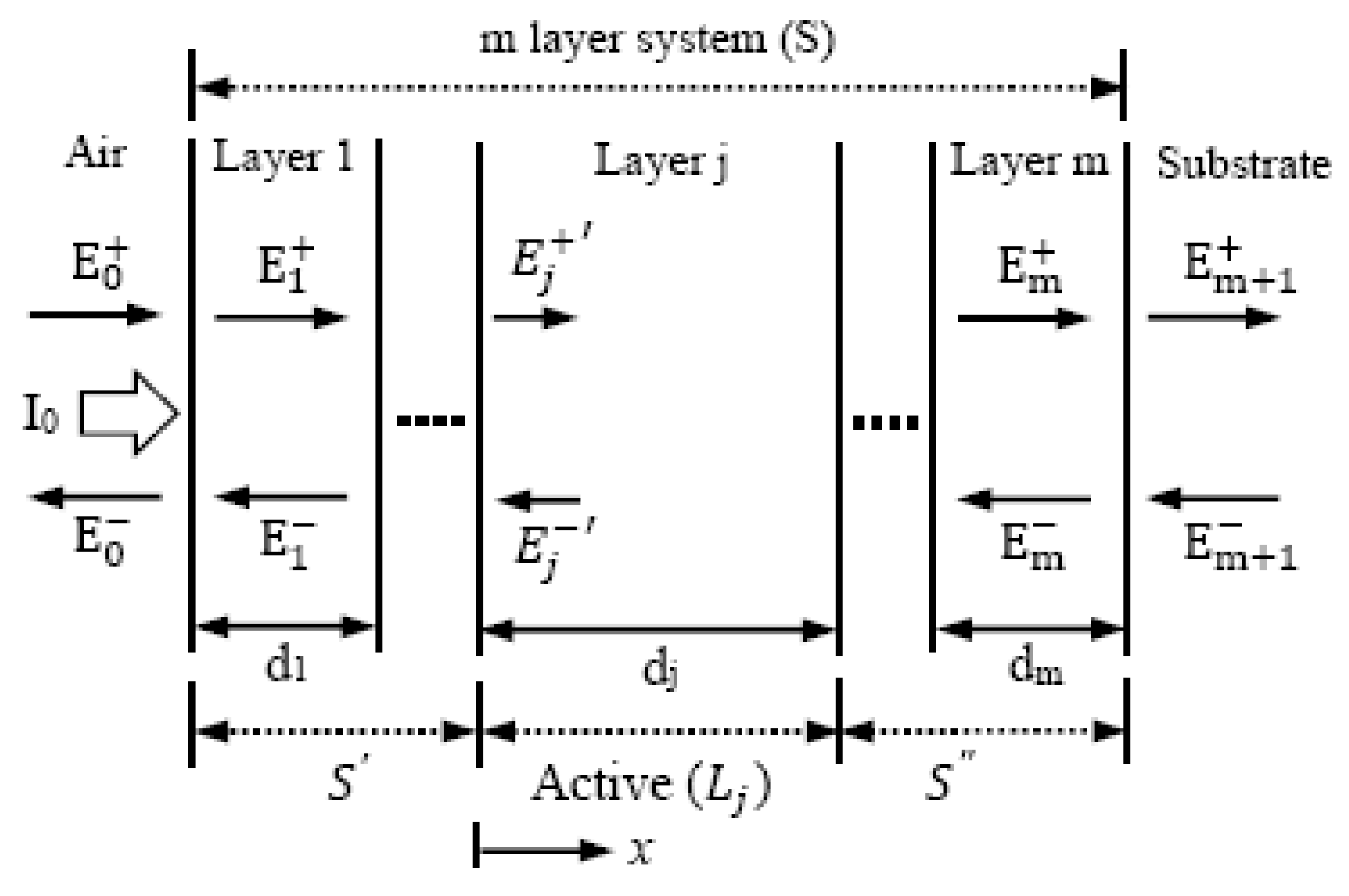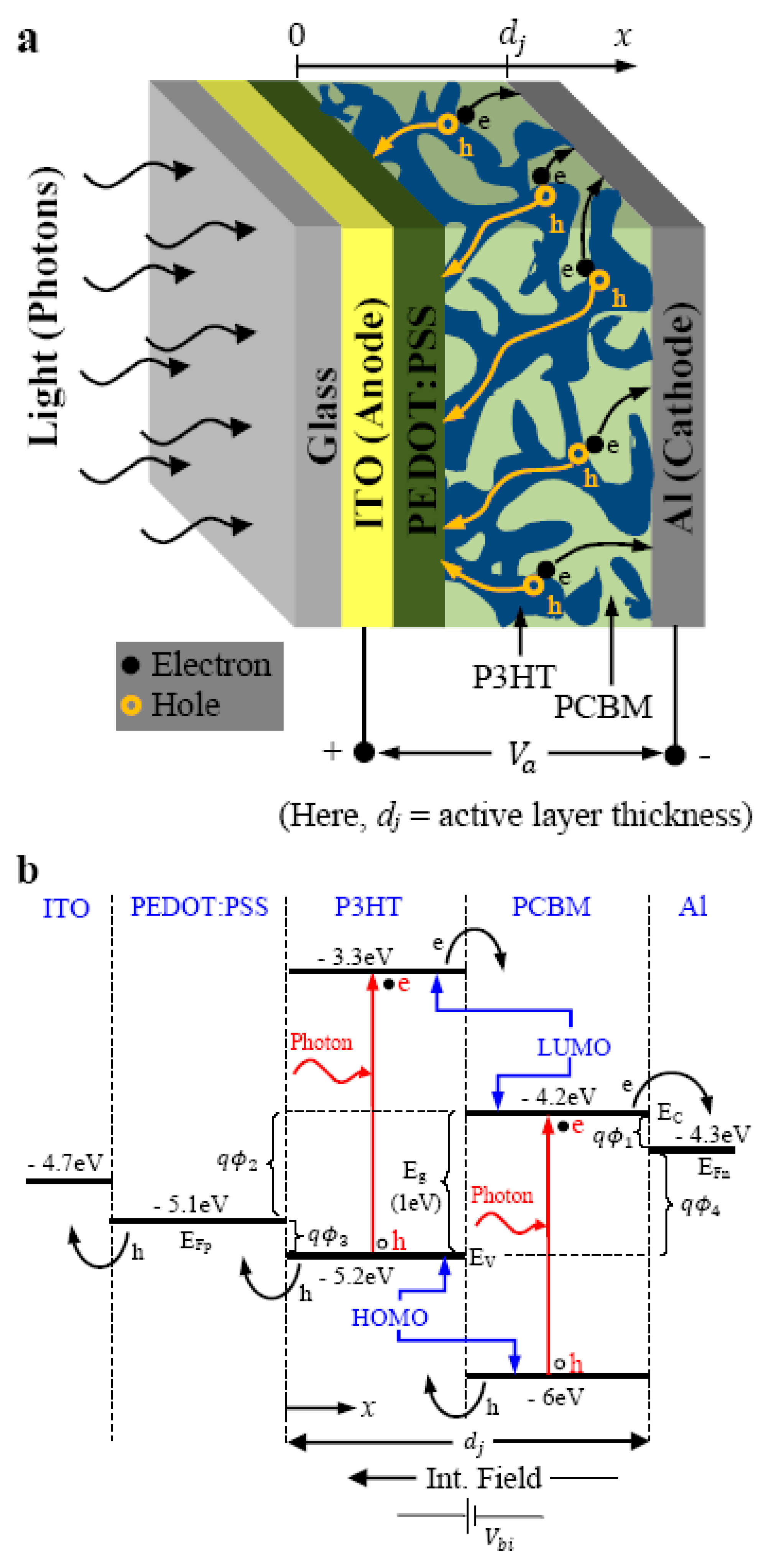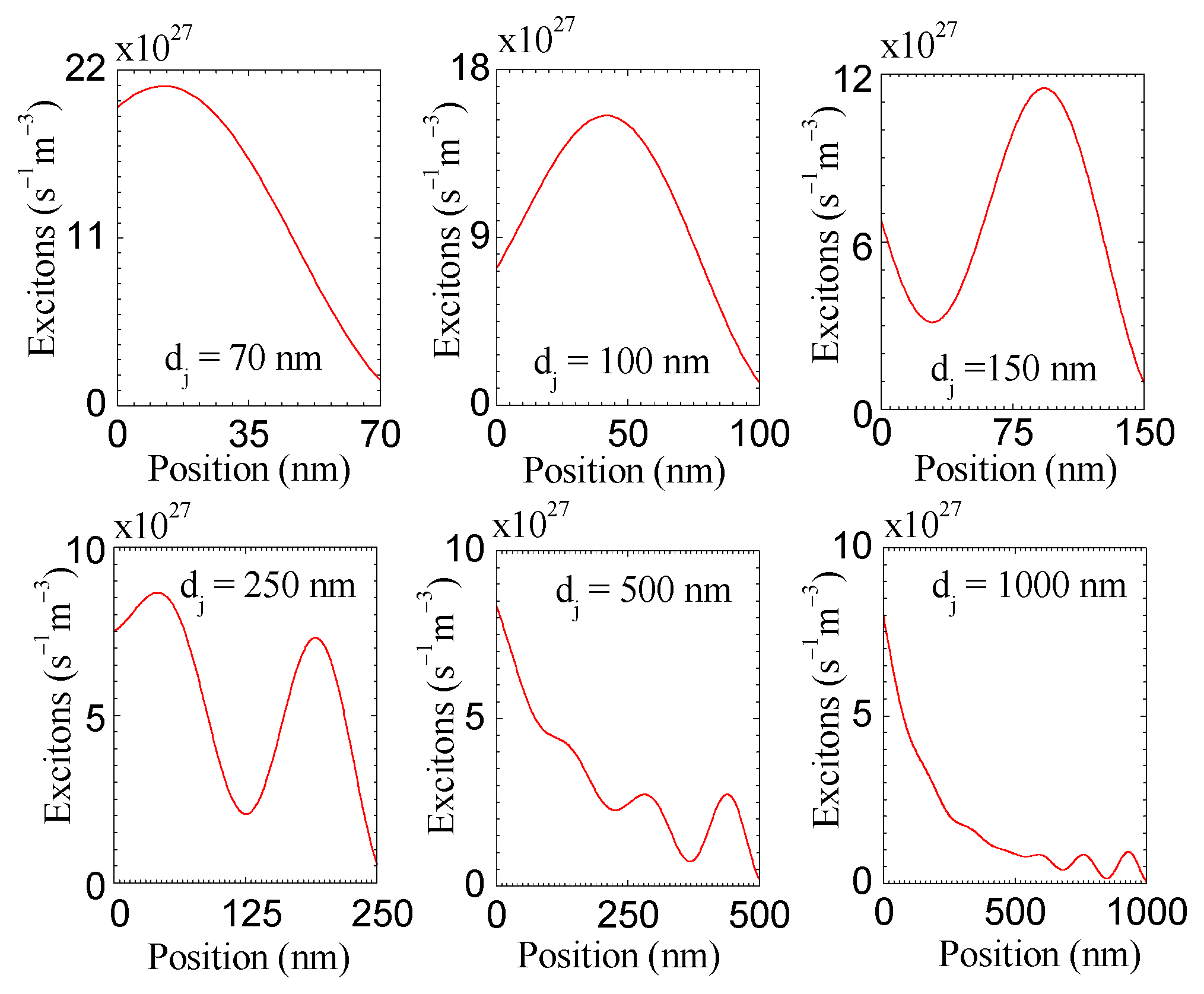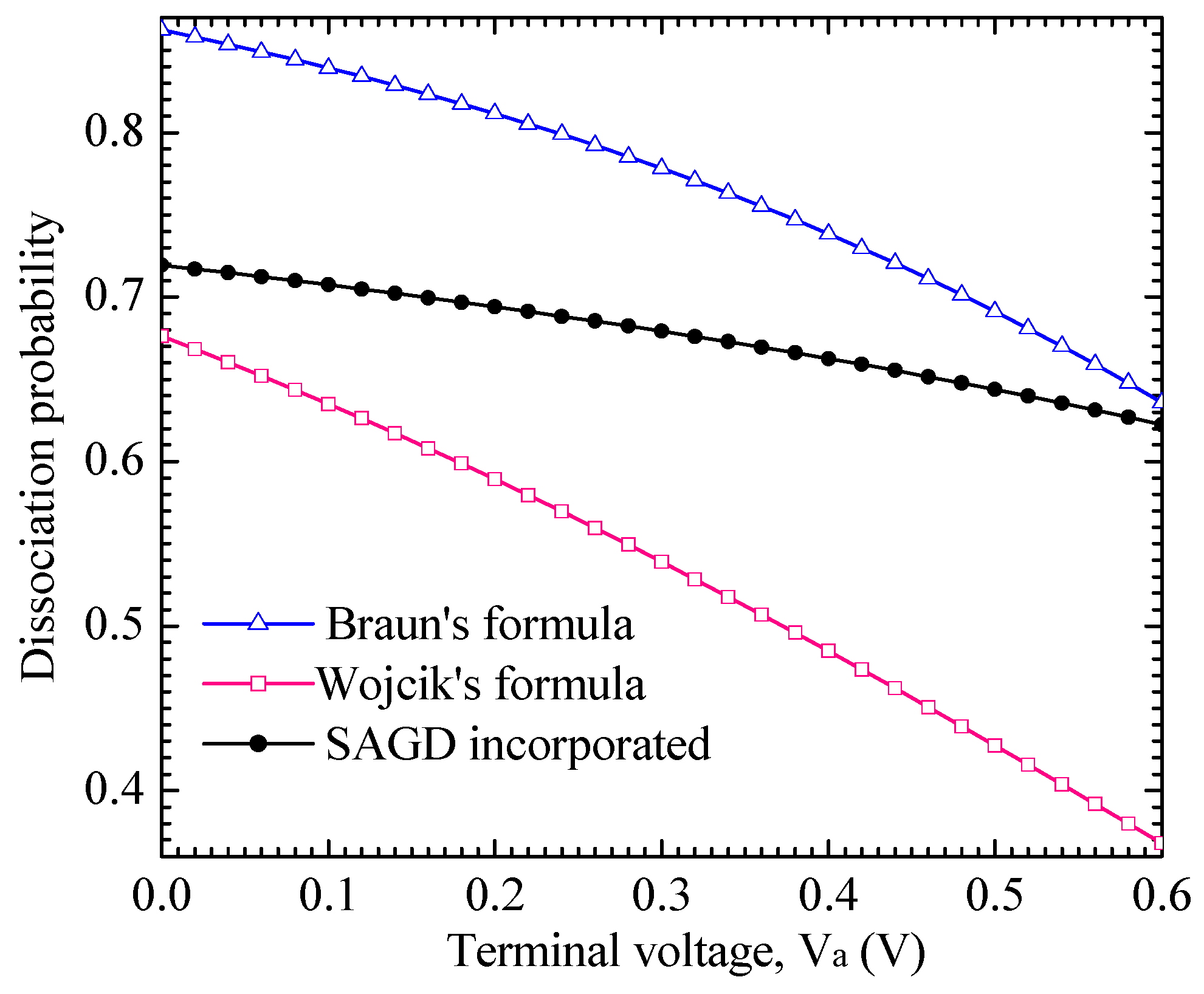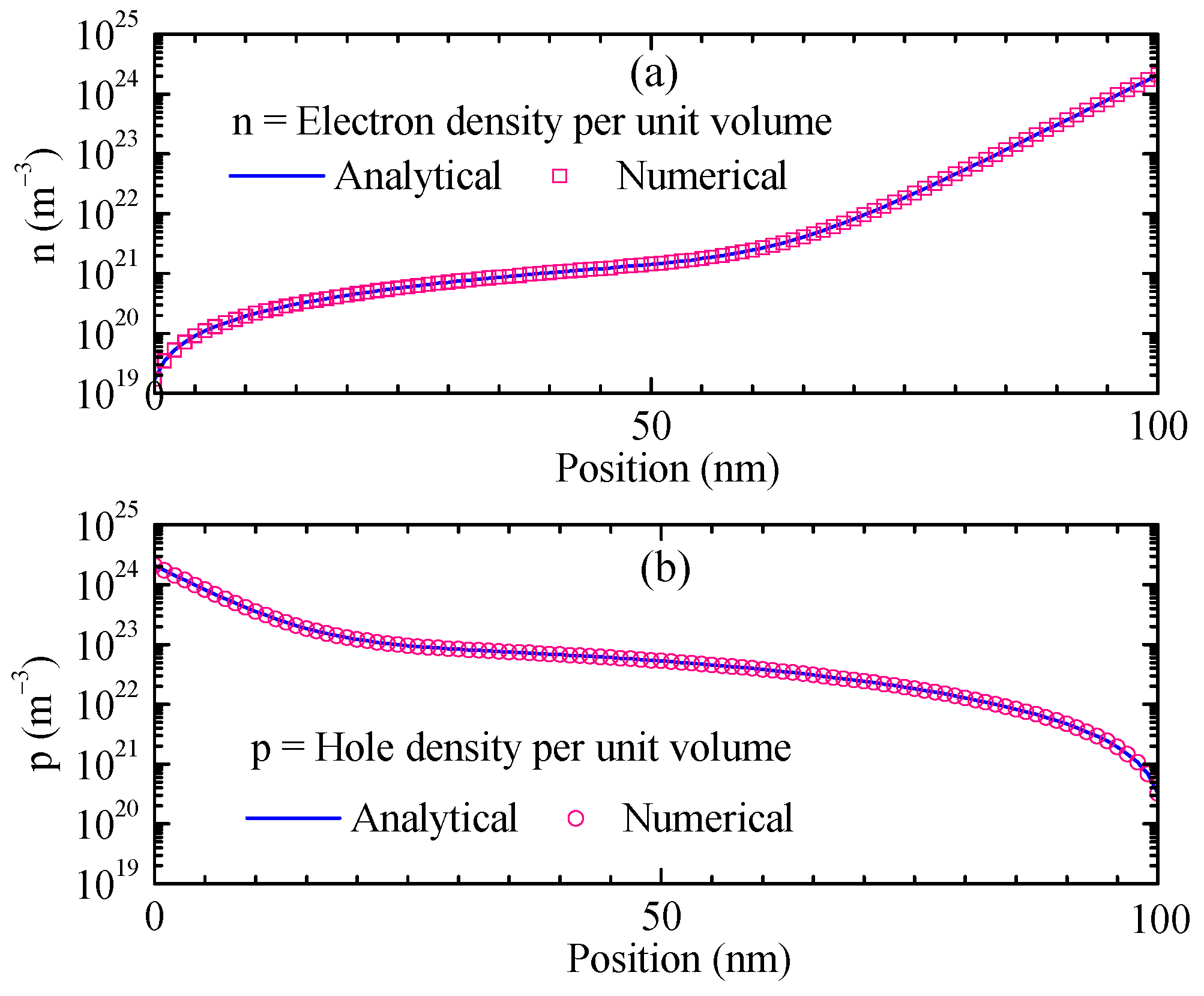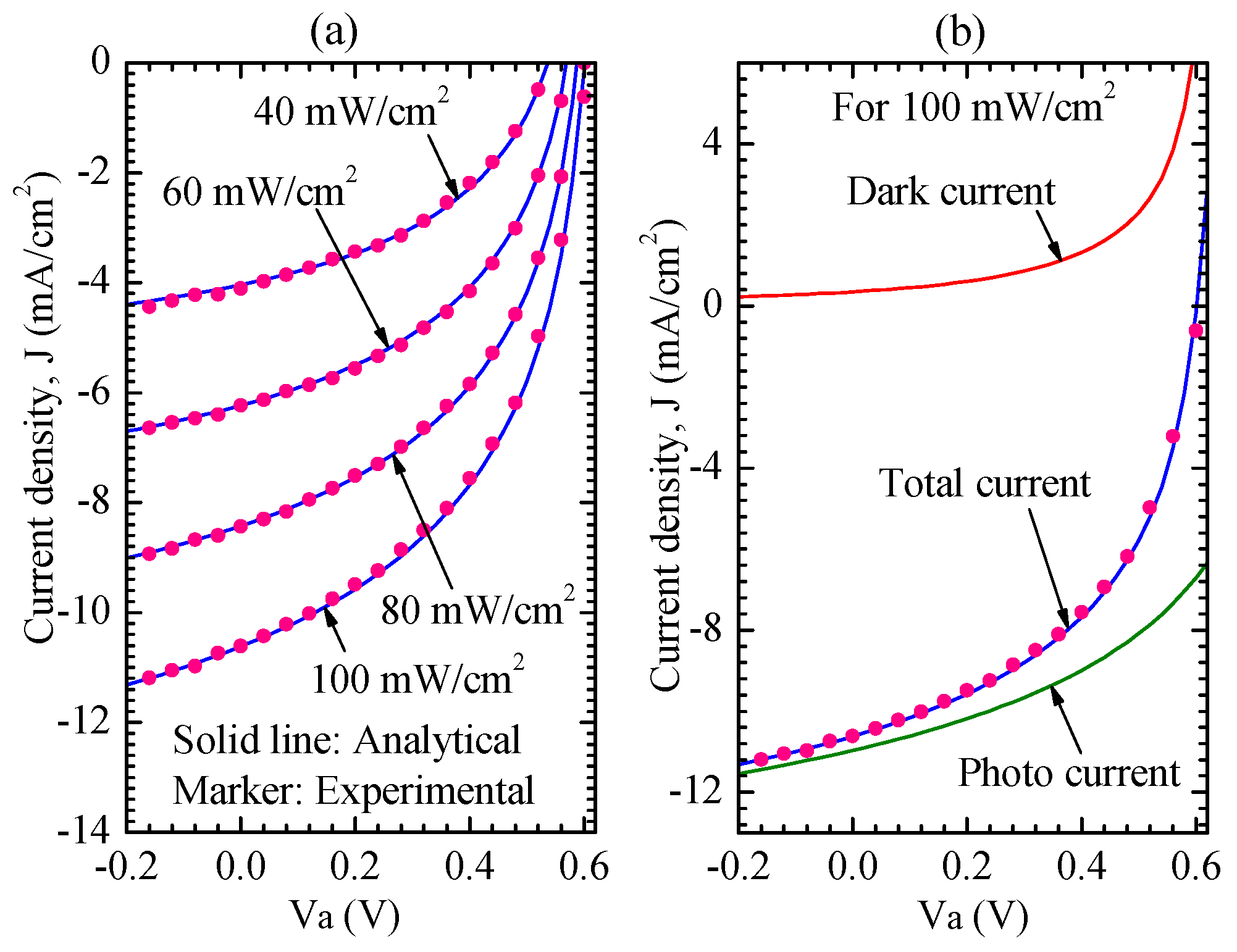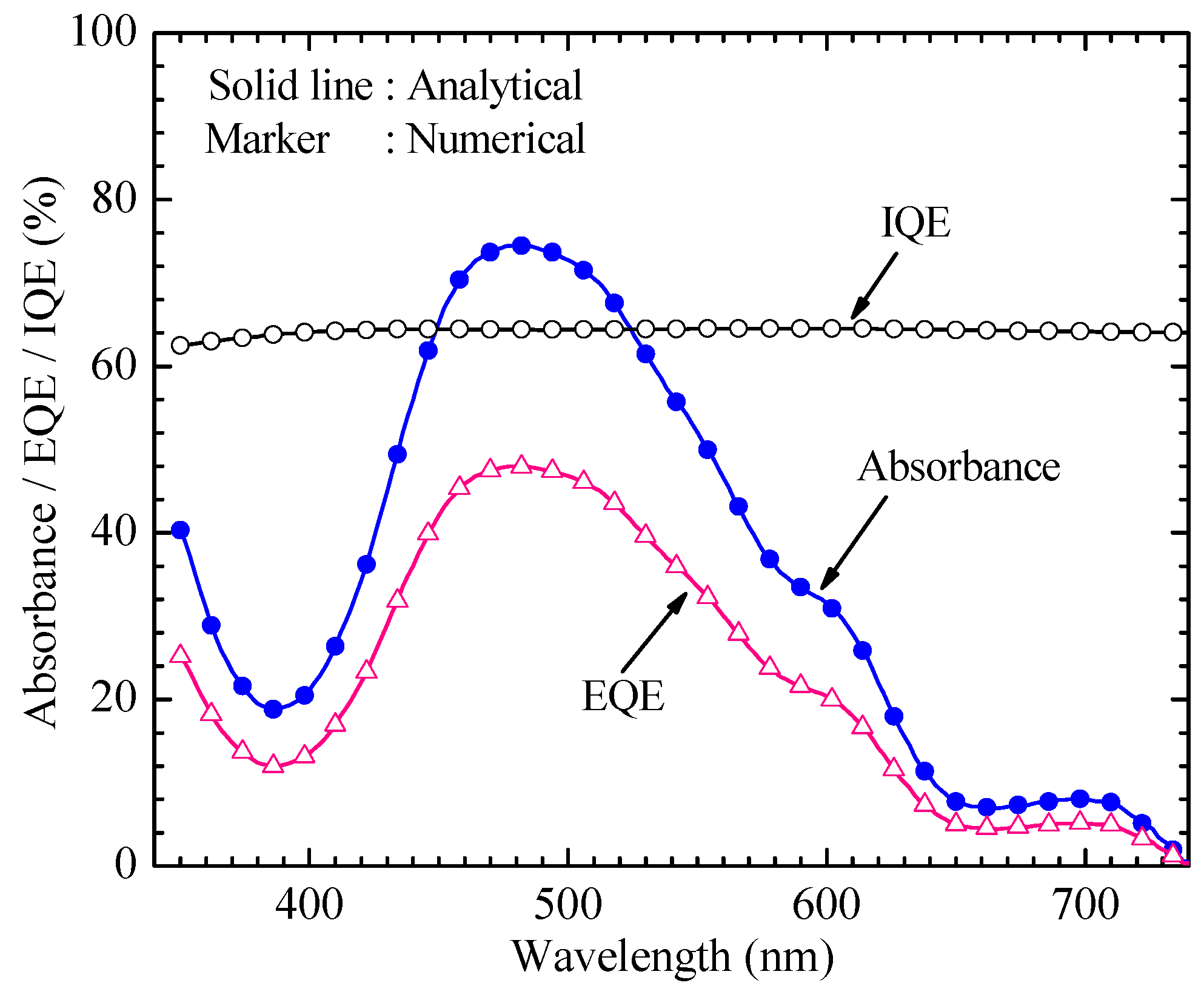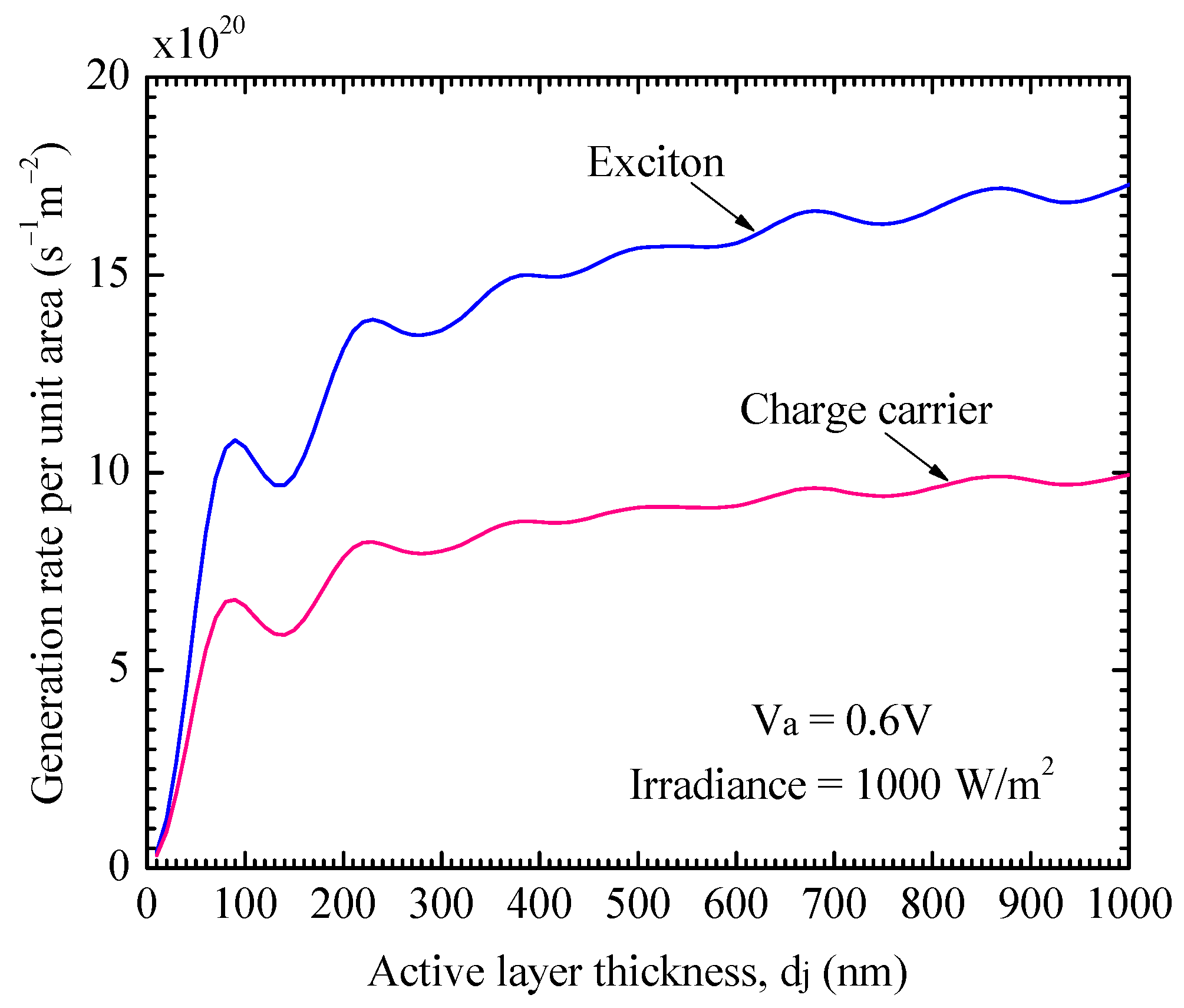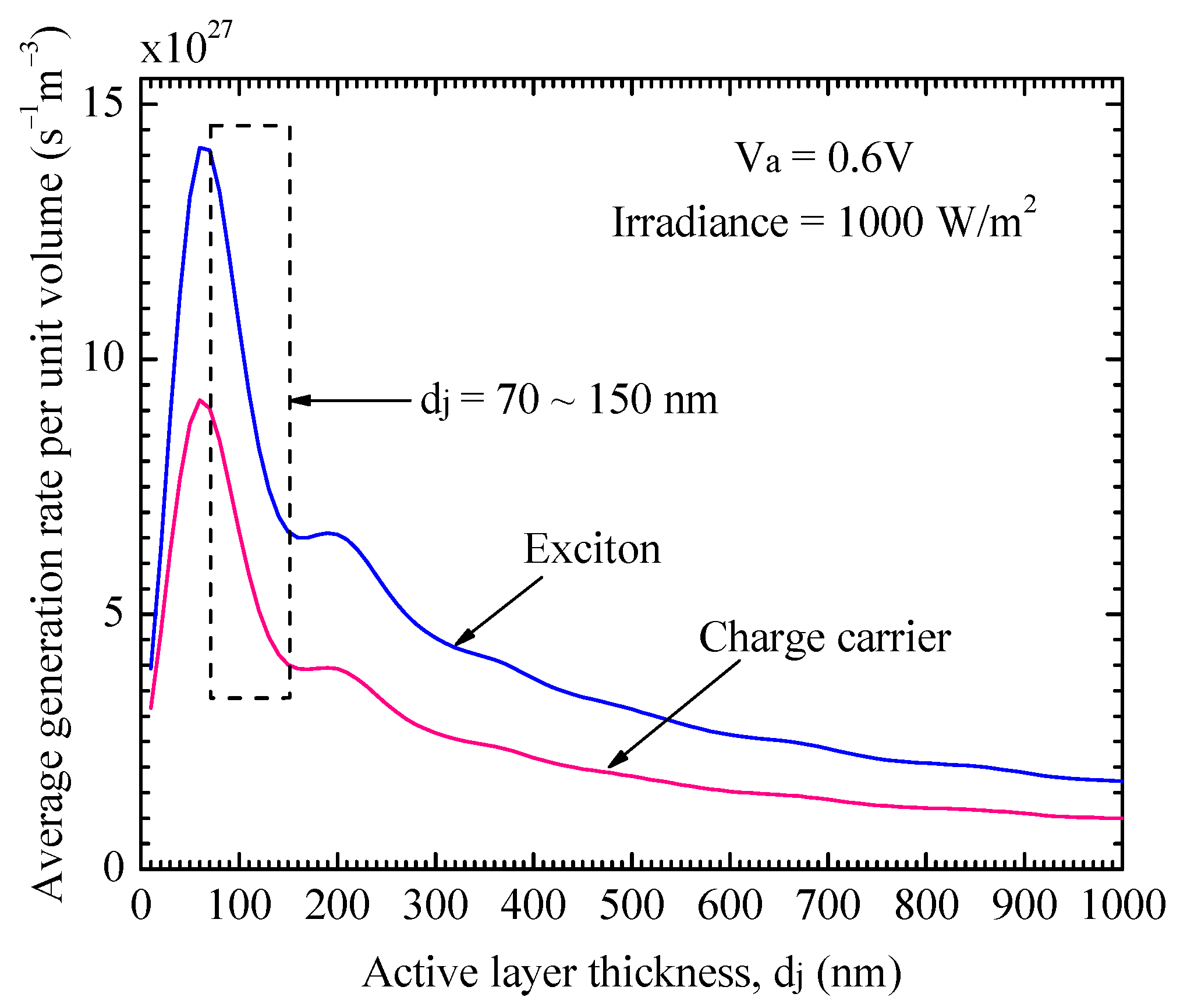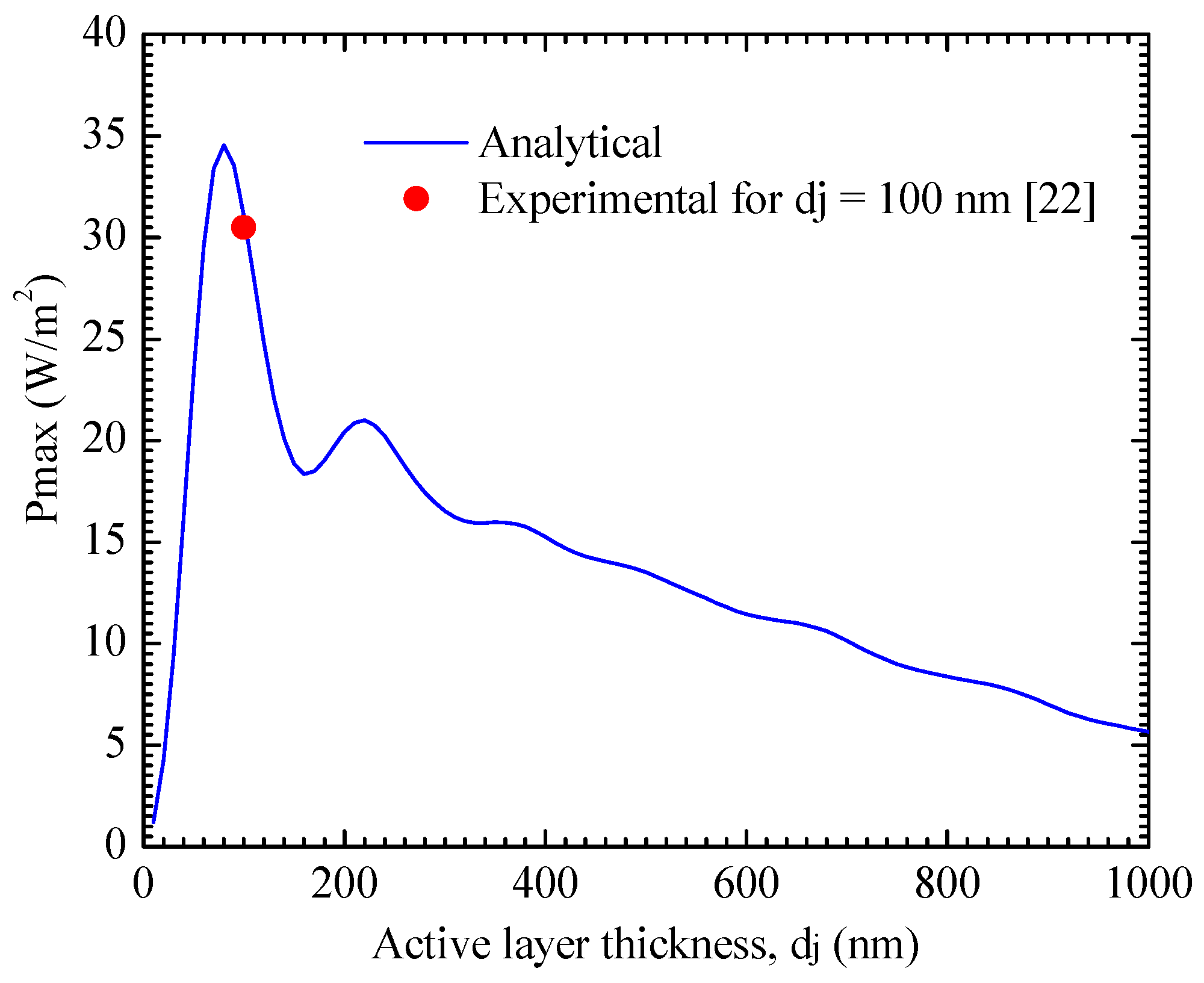1. Introduction
An organic solar cell (OSC) looks like a good candidate for harvesting solar energy because it has some advantageous features compared to its counterpart conventional Si solar cells [
1,
2,
3]. OSCs are basically made of layers of different materials; one layer is photoactive which consists of two organic materials such that one organic material (usually conjugated polymer) has the property to donate electrons and another organic material (usually fullerene) has the property to accept electrons, i.e., donor and acceptor. Due to light absorption in the photoactive layer, excitons (firmly bounded electron-hole-pairs) are generated. Then these excitons are dissociated into free charge carriers (electrons and holes). Dissociation occurs when excitons interact with donor-acceptor interfaces, defects, etc.; donor-acceptor interface has an internal electric field like a pn junction diode; therefore, this interface is the most effective site for dissociation. A bi-layered OSC has only one donor-acceptor interface; only the excitons, generated very near to this single interface, can reach the interface and be dissociated. However, for bulk hetero-junction (BHJ) OSC, the active layer is made of a mixer of donor and acceptor materials, lots of donor-acceptor interfaces, hence almost all generated excitons can get nearby interface and can be dissociated. As a result, BHJ OSC is more efficient than bi-layered OSC; therefore, many people [
4,
5,
6] are working with BHJ OSC for its improvement. Some researchers [
7] reported BHJ OSC with the internal quantum efficiency of 100%; but the useful external efficiency is only 10%.
For the further improvement of BHJ OSC, works regarding the structure and/or layer materials are required. The theoretical analysis (physics-based/simulation) can help in this regard. Some theoretical works have been done by numerical methods [
8,
9,
10,
11] and some other works have been done with analytical calculations [
12,
13,
14].
Although few numerical methods are robust regarding initial guesses, for most of the numerical methods it is observed that they are complicated and highly dependent on an initial guess, whereas, analytical calculation provides more correct results directly without the need for an initial guess. In this work, BHJ OSC will be investigated using analytical calculations. The accuracy of the analytical result depends on the way of treating the generation of excitons, dissociation of excitons into charge carriers, and recombination of charge carriers.
Regarding the use of generation rate in analytical calculations, some researchers [
12] utilized empirical fitting quantities; some other group [
14] used constant generation rate for making analytical calculations easier. However, for a thin layered device like OSC, constant generation rate approximation is not suitable, because due to thin layer, the incident light will not be reduced to zero while passing a layer, and hence it will be reflected and refracted at the interface with next layer, then there will be interference between incident-light and reflected-light, hence, the resultant light intensity will be different at different positions. As a result, the excitons will be different at different positions, i.e., excitons will be position dependent. Many researchers used exciton generation rate exponentially decreasing with position (Beer–Lambert law), but this neglects the impacts of optical phenomena (refraction, reflection, and interference). However, for the thin layered device, the effects of optical phenomena cannot be ignored, hence exponentially decreasing generation rate model would not be suitable also. Again, depending on the bandgap size of active layer material, photons with some wavelengths will be absorbed effectively, some other wavelengths will not be so effective, that is, the exciton generation will also depend on wavelength. The Optical Transfer Matrix Method (OTMM) considers the effects of optical phenomena and wavelength-dependent properties of layer materials, hence OTMM provides the generation rate as the function of both position and wavelength [
3,
11,
15,
16]. Therefore, the OTMM-based generation rate is most suitable for thin layered OSC and hence it has been used in this work for a more accurate result.
Regarding recombination, we see that many analytical works [
14,
17,
18,
19] neglected recombination; but recombination is a vital factor as it affects current and other performances [
20]. Some analytical works considered recombination, but they used generation rate either constant [
21] or exponentially decreasing [
22]; however, as stated earlier, the constant or exponential model is not as accurate as the OTMM-based generation rate for the thin layered device. Some other works [
18,
19] used OTMM based generation rate but neglected recombination.
Another factor is the dissociation rate function used for calculating dissociation probability for computing charge carriers from the excitons. Based on Onsager’s theory [
23], Braun introduced the dissociation rate function [
24]. Previous researchers [
8,
11] used the Braun model, and recently, people [
21,
25] are using the Wojcik and Tachiya model which is an improved version of the Braun model. Both models used constant (same) separation distance between electron and hole for all excitons. However, naturally, for any device, the electron-hole-separation distances will be different for different excitons because of the difference in photon-energy producing excitons. To address this fact, a standard distribution function may be applied along with Braun or Wojcik model.
To the best of my knowledge, in literature, no analytical work on OSC considered (i) OTMM-based exciton, (ii) dissociation probability including standard distribution function, (iii) recombination of charge carriers, all together. While including all these three factors together, the analytical solution becomes complicated, however, it is assumed necessary to get a better result. Again, most of the reported works usually calculate J-V, P-V, efficiency for a fixed condition; there are few works on the investigation with the variety of different factors, especially, no investigation work used above factors altogether. Moreover, almost all reported analytical works presented the final form of analytical expressions, no details about the derivation, in that case, it does not become clear about the limitations or assumptions used in the derivation.
To fill the aforementioned deficits in literature, this work has been done with the following targets. Target 1: Improved analytical calculations of OSC performances including the following three factors all together: (i) exciton generation rate obtained from OTMM to include optical phenomena, (ii) dissociation probability obtained by incorporating Gaussian distribution to consider the natural fact of the difference in electron-hole-separation distances, (iii) recombination of charge carriers. Target 2: Analysis of different OSC properties in detail with the variation of terminal voltage, irradiance, wavelength, active layer thickness using the above-mentioned improved analytical calculation. Target 3: The detailed derivations of analytical expressions with a view to making the work clear regarding limitations and assumptions and easy understanding for the OSC researchers, especially, for the new ones.
2. Excitons
When light falls on thin-layered OSC, excitons are generated by photons inside the photo-active layer (organic material). The distribution of light (hence the distribution of excitons) inside the active layer may be obtained by using the Optical Transfer Matrix Method (OTMM). Many works used OTMM-based equations. However, detailed derivation of OTMM-based equations is being presented here for better understanding.
Let us consider m layer (thin) device sandwiched between air and substrate (thick) as shown in
Figure 1. The air is designated as
layer and the substrate as
layer.
According to OTMM, while light crosses the interface of layer 0 and layer 1, the refraction and reflection behavior of light may be expressed by an interface matrix
, for perpendicular light falling, as follows [
11].
where,
and
are complex refractive indices of layer 0 and layer 1.
Again, according to OTMM, while light passes through layer 1, the absorption behavior of light may be expressed by a layered matrix
, for perpendicular light falling, as follows [
11].
where,
;
thickness of layer 1;
change of phase angle as the light passes through the layer 1.
Similarly, calculating all interface matrices and layer matrices, for the whole structure, a scattering matrix (transfer matrix)
may be formed as follows.
At any position inside the device, the optical electric field (
) has two components:
(forward component along positive
) and
(backward component along negative
) as shown in
Figure 1.
The components of
inside
layer may be related to those inside
layer via the
matrix as follows.
As the substrate is thick, no reflected light inside substrate, i.e., . Using in the above equation, we may get, and . Now for whole system, we may get reflection coefficient, and transmission coefficients, .
To determine the distribution of light (hence distribution of excitons) inside the active layer (
layer), we need to treat the active layer matrix
separately. Therefore, the
matrix may be divided into three segments such that
.
Like the whole system (), reflection and transmission coefficients for subsystems ( and ) may be defined as ; ; ; .
Assuming the left edge of the
layer is
= 0, the optical electric field
at a position
inside the
layer can be written as
If we assume
and
as the forward and backward field components at the beginning of
layer (
Figure 1), then we get Equation (8) (see
Appendix A).
If we define an internal forward transfer coefficient (
) as
then we get Equation (9) (see
Appendix B).
The value of
may be found by the Equation (10) (see
Appendix C).
As
is a complex term, it can be expressed in polar form as
where
are the magnitude and angle of
. By putting
and
in Equation (9), we get
Putting
in Equation (11) and algebraic manipulation gives the Equation (12) (see
Appendix D).
where,
.
Note that, is the absorption coefficient (unit: m−1).
Assigning,
we may write Equation (12) as
Irradiance (
) may be expressed as,
=
, where
light speed,
= electric permittivity,
= vacuum permittivity,
= relative permittivity or dielectric constant,
= electric field (see
Appendix E).
Accordingly, the irradiance at position
x in
layer is,
Using the relation between refractive index and electric permittivity,
may be expressed by Equation (15) (see
Appendix F).
If the irradiance
(unit: Wm
−2 or Js
−1m
−2) is multiplied with absorption coefficient
(unit: m
−1), it will give the power dissipated per unit volume as
(unit: Js
−1m
−3). We know, photon energy
(unit: J); where
Planck’s constant. If we divide
by photon energy, we will obtain absorbed photon rate per unit volume (
) (unit: s
−1m
−3) as
Like many other researchers [
11], it may be assumed that each photon produces one exciton in P3HT: PCBM based OSC. Therefore, the exciton generation rate per unit volume,
(unit: s
−1m
−3) would be equal to
.
6. Results and Discussions
An organic solar cell (OSC) having the structure “Glass/ITO/PEDOT: PSS/P3HT: PCBM/” has been investigated in this work.
Figure 1 shows the device structure to describe the theory of Optical Transfer Matrix Method (OTMM), as per theory in literature, light is incident from air to layer-1 and proceeds, OTMM theory defines the material after the last layer (layer-m) as the substrate, which is thick, no reflected light inside the substrate. In the device structure concept, the “Glass” layer is usually called the substrate since the whole device is built on it. The “substrate” in OTMM theory is not the same as “substrate” in the device structure concept. In the above-mentioned device structure, light is incident on the glass and proceeds, if we apply the OTMM equation in the same direction of light,
will be the last layer, the “air” after
layer will be considered as the substrate, the (m + 1)
th layer for calculation.
The refractive index (), extinction coefficient (), and the thickness of the layers are used to calculate interface matrices and layer matrices by Equations (1) and (2) defined by the Optical Transfer Matrix Method (OTMM). Then the elements of these matrices and the solar irradiance (Io) are used to calculate generated excitons by the derived analytical equation. Then charge carriers, current, power, etc. are calculated by the corresponding analytical equations using these excitons. Thus, the derived analytical equations include the device structure size, material property, and solar light intensity in the calculation of OSC performances.
Spectral values of
and
of the materials, used for the OSC device, have been collected from literature [
31].
The solar light intensity of a place depends on whether the Sun is at the vertical position or at an inclined position relative to that place, the inclination is represented by an index, called air mass (AM). Like many other researchers [
2,
3,
7,
8,
11,
14,
20,
21], this work has used solar irradiance of AM 1.5 (global) taken from standard source (ASTM G-173-03) [
39].
The Equation (18), derived from OTMM, provides the generation rate of excitons as the function of position (
x) and wavelength
. The equation requires I
o with the unit of Wm
−2; however, in the standard dataset [
39], irradiance I
o is recorded with the unit Wm
−2nm
−1 (i.e., Wm
−2 per nanometer bandwidth of wavelength), therefore, for calculating photo-excited part of any quantity (exciton, charge carrier, current) integration with respect to
for the range of effective wavelengths is needed; when integrated wrt
, then
(which has the unit nm) cancels nm
−1 part of Wm
−2nm
−1 then I
o carries the required unit Wm
−2 and hence the calculated (integrated) quantity is obtained with the standard unit.
Regarding the wavelength range, for the analysis of similar devices, some groups [
11] used the wavelength range of 350–800 nm; some others [
27] used the range of 350–850 nm; in this work, the wavelength range of 350–850 nm has been used.
To see the effects of optical phenomena on the exciton generation, and hence to see the suitability of using OTMM, the spatial distribution of excitons has been investigated. For a position inside the active layer, total exciton for all wavelengths has been evaluated by integrating the exciton obtained using OTMM based Equation (18) over the wavelength range of 350–850 nm. Similarly, the total excitons for all positions have been evaluated and hence the spatial variation of excitons has been obtained.
Figure 3 shows the spatial variation of exciton generation rate inside active layer of OSC shown in
Figure 2a with the irradiance of 1000 W/m
2 for active layer thickness (d
j) of 70, 100, 150, 250, 500, 1000 nm. The result of OTMM shows wave-like (pulsating) variation of exciton generation rate with the position; due to interference of incident light and reflected light the light intensity becomes stronger or weaker at places and hence pulsating variation of excitons occurs. The figure also shows that as the active layer thickness increases, the variation pattern changes from pulsating nature towards decreasing nature. When active layer thickness is very large, the variation exhibits an exponentially decreasing nature which is the same as stated by Beer-Lambert law; the agreement with “law” validates the use of the OTMM. The peak value of exciton generation rate is found in the range of 8 × 10
27 − 20 × 10
27 s
−1m
−3 (≡8–20 s
−1nm
−3). The pattern of variation and level of values are consistent with the reported results [
10,
17,
40]. The pulsating variation confirms the effects of optical phenomena, that is, OTMM provides the correct profile of excitons considering optical phenomena and hence suitable for thin layered OSC research.
To find the appropriate dissociation probability, it has been calculated by Equation (19) using dissociation rate
of Braun’s formula given in Equation (20) and
of Wojcik’s formula given in Equation (22) and then calculated by Equation (23) incorporating Gaussian distribution function. Some researchers [
8,
11,
29,
30] used Braun’s formula and some others [
21,
25] used Wojcik’s formula, they used a constant value of separation distance (
) between electron and hole of an exciton, however, the separation distance value, used in the calculation, should be a representative value for all excitons, we may perceive
as the average value. To find the appropriate value, the separation distance (
) has been taken as a variable (not constant) and dissociation probability has been calculated using Braun’s formula and Wojcik’s formula.
Figure 4a shows the variation of dissociation probability with separation distance (
) for four-terminal voltages (
) of 0 V, 0.2 V, 0.4 V, and 0.6 V, calculated using Wojcik’s formula. For a certain
(i.e., certain field), with the increase of separation distance (
), dissociation probability is found to increase from zero to unity. This is logical because when the separation distance is larger, electron-hole-pair (EHP) of that exciton is loosely bounded, hence more feasible to dissociate, therefore, higher dissociation probability. Now the question is, which value of dissociation probability (i.e., which value of separation distance) should be used? The probability increases almost linearly from 0 to 1, hence the average (middle) value of probability (0.5) may be accepted as the representing value for probability; therefore, its separation distance may be assumed as the average separation distance and may be accepted as the representative value for
. However, we see in
Figure 4a that the probability value of 0.5 happens with a smaller
for a smaller
and vice versa. This is also logical because we know field
. We know
increases from zero, when
becomes equal to
, the field becomes zero, the solar cell stops to charge the external battery, that is,
cannot be larger than
, the field cannot be positive, the field is always negative (hence current is negative). When
, field magnitude is the largest, when
increases from zero, field magnitude decreases. For smaller
, field magnitude is larger which becomes capable to dissociate EHP with lower separation distance (even they are strongly bounded) and hence the probability of 0.5 occurs at lower
. Similarly, for larger
, the probability of 0.5 occurs at higher
. The separation distances, corresponding to the probability of 0.5, have been investigated for solar cell working range
; the average of these separation distances has been obtained as 1.51 nm, which may be used as the representative value for
in calculation; this average value (1.51 nm) is consistent with the constant value used for separation distance in previous works [
21,
25].
However, the concept of using a constant value of assumes that all excitons have the same separation distance, again, the concept of using the average value of assumes that the population of excitons would be the same at all separation distances; but both these assumptions are not compatible because naturally separation distances would be different and also population would be different.
To commensurate with the natural situation, spherically averaged Gaussian distribution (SAGD) may be incorporated in the calculation of dissociation probability as in Equation (23). For every separation distance (
), the probability value (calculated by Braun’s formula or Wojcik’s formula) is multiplied with the SAGD function value at that separation distance to obtain SAGD incorporated probability.
Figure 4b shows the SAGD incorporated probability versus
for four-terminal voltages (
) of 0 V, 0.2 V, 0.4 V, and 0.6 V, calculated using Wojcik’s formula incorporated with the SAGD function. Note that
Figure 4b shows the plotting of the integrand of Equation (23) and it has the unit of m
−1.
The dissociation probability has been calculated by using Braun’s formula, Wojcik’s formula, and Wojcik’s formula incorporating SAGD function and compared;
Figure 5 shows the comparative picture of the probability with the variation of
for solar cell operation range (
0–0.6 V). For Braun’s and Wojcik’s formulae, the separation distance of
m has been used. To obtain the overall value of SAGD incorporated probability, Equation (23) needs to be integrated, that is, the curve in
Figure 4b needs to be integrated. The integrand of Equation (23) is not integrable analytically, the integration has been computed numerically. Ideally, the integration range should be
= 0 to ∞. From the analysis it was found that for
m or less, the value of the integrand is negligible (order of
) compared to the highest value (order of
), similarly, for
m or more, the value of the integrand is negligible, therefore, numerical integration has been carried out for the range
m to
m.
For all three methods, the overall probability was found to decrease with the increase of . This is logical because, with the increase of , the field magnitude decreases, hence the dissociation probability decreases.
For solar cell operation range, i.e., for
0–0.6 V, Braun’s formula, Wojcik’s formula, and SAGD incorporated formula provide the dissociation probability values of 0.63–0.86, 0.36–0.67, and 0.62–0.72, respectively. For a similar device (P3HT:PCBM-based), some researchers [
41] reported the dissociation probability of 0.4–0.74 for
0–0.6 V with constant separation distance. Some other works [
42,
43] reported the dissociation probability as the function of effective voltage. As the externally applied voltage and internal built-in voltage work in the opposite direction, the effective voltage may be defined as,
; in this work,
is 0.8 V, therefore, for solar cell operation range,
0.2–0.8 V. For the same range of
, Tan et al. [
42] reported a probability of 0.6–0.78 and Hao et al. [
43] reported a probability of 0.5–0.8. The dissociation probability values obtained in this work are consistent with the values reported in other works.
Figure 5 shows that Braun’s formula provides a higher value of dissociation probability, Wojcik’s formula provides a lower value and SAGD incorporated calculation gives the value in between them. The SAGD incorporated probability is thought to be most appropriate because of considering naturally expected population variation of excitons, therefore, this probability has been used in this work.
The current-producing electron density per unit volume
has been calculated by using Equation (35) which is the analytical solution of the differential Equation (28), then analytical results have been compared with those obtained by numerical solution of the same differential equation. Similarly, current-producing hole density
has been calculated using analytical Equation (49) and compared with the numerical result.
Figure 6a,b show the variation of current producing electron and hole density with the positions inside active layer for OSC having an active layer thickness of 100 nm operated at
with an irradiance of 100 mW/cm
2. Analytical results (solid lines) are exactly matched with numerical results (markers); this indicates that analytical solutions (expressions) are correct. The charge carrier density for the stated condition is found to vary in the order from 10
20 m
-3 to 10
24 m
-3 inside the active region as shown in
Figure 6, the average value is in the order of 10
23 m
−3. For a similar device, some researchers [
44] reported a charge density of 6×10
15 cm
-3 (≡ 6×10
21 m
-3); another group [
45] reported a charge density in the range from 10
21 m
-3 to 10
23 m
-3; the charge density in this work is found consistent with previous reports. Note that, for numerical solution of differential equation, “bvp4c” solver, a built-in routine of MATLAB, has been used.
For a certain device [
22], the total current density has been analytically calculated using Equation (61) at different values of
for four levels of irradiance 100, 80, 60, and 40 mW/cm
2, and the analytical results have been plotted along with experimental values. The analytical and experimental results [
22] are in good agreement as shown in
Figure 7a. Again, the dark component of current has been calculated by the summation of the dark current due to electron by using Equation (43) and dark current due to hole by using Equation (57). Similarly, the photo-exited component has been calculated by the summation of the photocurrent due to electron by using Equation (44) and photocurrent due to hole by using Equation (58). The extracted dark current and photocurrent for the irradiance of 100 mW/cm
2 have been presented in
Figure 7b. The separation of dark current and photo-current gives a better view than the plotting of total current only.
The analytical calculations in this work have been carried out using some parameters with the standard values and some others as fitting parameters, whose values have been found while fitting analytical results with experimental ones.
Standard values are: , , , , , , , , , , , , . The fitting parameters are: , , , , .
The parameter values are consistent with previous works [
18,
19,
29,
31,
46,
47]. For such work, the calculation must consider recombination, exciton generation, dissociation probability of excitons; these factors cannot be left out. Some researchers neglected recombination, some used constant exciton generation, some used constant separation distance between electron and hole of the exciton to calculate dissociation probability, no work used these factors together. However, this work includes all these factors together, moreover, it uses an improved estimation of excitons and dissociation probability, such as, it uses recombination, OTMM based exciton generation to account for different excitons at different positions, SAGD incorporated dissociation probability to account for the difference in separation distances, therefore, the parameter values extracted in this work are expected to be better, that means, calculation using these parameters would predict OSC performances more accurately, for any irradiance other than the investigated irradiances.
The effects of irradiance on the external properties (V
OC, J
SC, FF, PCE) of OSC have been investigated by calculating them analytically for different irradiance levels and compared with experimental values [
22]. The external properties are found to vary with irradiance as shown in
Figure 8; the analytical and experimental results are found consistent. The magnitude of J
SC increases with irradiance as shown in
Figure 8a, this is expected because higher irradiance will produce a larger current. V
OC changes with irradiance as shown in
Figure 8b. Theoretically [
48,
49] V
OC may be calculated by the equation,
. Here PCBM is acceptor with
= − 4.2 eV = −6.72 × 10
−19 Joule and P3HT is donor with
= −5.2 eV = − 8.32 × 10
−19 Joule. For irradiance 1000 W/m
2, average
has been calculated as 1.1025 × 10
23 m
−3 and average
as 1.4994 × 10
23 m
−3 and then using this
and
in the above theoretical equation, the value of
has been found as 0.65V, which is very consistent with the value 0.61 V found by analytical calculation in
Figure 8b. V
OC exhibits negligible dependence on irradiance, this can be explained with the above theoretical equation. In the equation, all quantities are constant except
and
. With the change of irradiance,
and
change but not with the order (level), therefore, the logarithm of
does not change much with irradiance, as a result, V
OC does not change much. Similarly, FF has negligible dependence on irradiance as shown in
Figure 8c. PCE increases with irradiance as in
Figure 8d. The power loss inside the device mostly depends on the material and not on irradiance, that is, power loss is almost constant for any level of incident power. If we calculate loss percentage with respect to low incident power, loss percentage would be higher, hence, efficiency would be lower. On the other hand, for higher incident power, loss percentage would be lower, hence, efficiency would be higher. These trends of variation and level of values for these properties of OSC are consistent with the reported results [
13,
14,
44,
46].
The internal properties (absorbance, EQE, and IQE) of OSC have been analyzed by calculating them by analytical expressions developed earlier. Absorbance has been calculated by using the analytical Equation (62). Average photocurrent
has been calculated by using Equation (63) and then EQE by Equation (64) Again, IQE has been evaluated by using absorbance and EQE in Equation (65). These equations provide the result for a single wavelength. Similarly, by calculating internal properties for different wavelengths, the spectral variations of the internal properties have been obtained.
Figure 9 shows the spectral variation of absorbance, EQE, and IQE for active layer thickness 100 nm and irradiance 1000 W/m
2. The analytical results fully matched with numerical results as shown, this indicates that these analytical equations are correct. For absorbance, the variation pattern and level of values are consistent with the reported results of such devices [
34,
50,
51,
52,
53,
54]. A similar shape is also observed for EQE which is consistent with reported works [
6,
50,
53,
54].
As absorbance and EQE have the almost same shape and IQE = EQE/absorbance, the shape of IQE is almost constant with the wavelength as shown in
Figure 9, a similar constant shape of IQE is also observed by others [
52].
The effects of variation of active layer thickness on the generation rate of excitons and charge carriers have been investigated as follows. For a certain value of active layer thickness (
), exciton generation rate has been calculated by using Equation (18) for a certain position and a certain wavelength; thus calculated for all positions inside active layer and all wavelengths. Then for a certain position, the results of all wavelengths have been integrated to get the effects of all photons; thus, calculated for all positions. Then the results of all positions have been integrated to get total excitons; when the exciton generation rate (unit: s
−1m
−3) is integrated with the position for the range of 0 to
, it gives exciton generation rate per unit area (unit: s
−1m
−2); this represents the number of excitons generated per unit time in the volume covering a unit area of incident-surface and length of whole active layer thickness. Such calculation of exciton generation rate per unit area has been carried out for several values of
. Then charge carrier generation rate per unit area has been calculated by the product of exciton generation rate and dissociation probability.
Figure 10 shows the generation rate per unit area versus
for both excitons and charge carriers. Both show deep ripples at lower values of
and shallow ripples at higher values of
. For some
, the interaction of incident and reflected light would be additive intensive and hence the generation would be high; whereas, for some
, the interaction would be subtractive intensive, and hence the generation would be low; therefore, the ripple. The overall trend of variation is, the exciton (per unit area) increases with
, this is because of the large space available for photon absorption. On the other hand, charge carrier = (exciton)(probability). We know, field
, for a certain
, with the increase of
, field decreases, and hence probability decreases. That is, with the increase of
, charge carrier has two effects: increasing effect of exciton and decreasing effect of probability; for a large value of
these two effects are nullified by each other, and hence charge carrier curve increases at a low rate, that is, almost flat as shown. This result is consistent with the results of current density, photons absorbed, the efficiency with the variation of active layer thickness obtained by other researchers [
14,
31,
32,
49].
We know, electrons and holes per unit volume is used for calculating the current, therefore, the charge carrier generation rate per unit volume needs to be investigated. As the generation rate per unit area indicates the amount in the volume covering a unit area of incident surface and length of whole active layer thickness, if we divide the generation rate per unit area by the active layer thickness then it will represent the amount in the volume of unit area and unit length, i.e., the average amount in unit volume, thus the average generation rate per unit volume (unit: s
−1m
−3) has been determined by dividing the generation rate per unit area by
, a similar calculation has been done for all values of
.
Figure 11 shows the generation rate per unit volume versus
for both excitons and charge carriers. With the increase of
, generation rate per unit volume has two effects: increasing effect of overall generation rate per unit area and decreasing effect due to division by
; at the low range of
, increasing effect is more, hence generation rate per unit volume increases; at
around 60 nm both effects become equal and the generation rate reaches to maximum, for
more than 60 nm, decreasing effect becomes dominant, hence generation rate per unit volume decreases as shown in
Figure 11.
Some previous work [
21] calculated J-V for
70 and 150 nm; some work [
25] calculated J-V for
80, 100, 120, and 140 nm; these works showed that current decreases with the increase of
; the present study also supports those previous results because we see that in the similar range (70–150 nm) of
, exciton (or charge carrier) generation rate per unit volume decreases with the increase of
, which is shown by the box in
Figure 11. However, there are some range of
for which exciton (or charge carrier) increases with the increase of
or remains almost constant as shown in
Figure 11, that is, the trend of decreasing current with the increase of
would not be true for all range of
, that means, this study provides a better and bigger picture regarding the effect of variation of
. From this analysis, it is seen that the generation rate per unit volume is the highest for the active layer thickness of 60 nm, therefore, it might be predicted that OSC would provide the highest performance with the active layer thickness of 60 nm. In the literature, we see that many research groups fabricated OSC having an active layer thickness of 100 nm (which is close to 60 nm); may be, they did not go with a lower thickness because of the fabrication challenge.
Maximum power
has also been investigated with the variation of active layer thickness;
is found to vary with active layer thickness as shown in
Figure 12, which has been obtained for irradiance of 1000 W/m
2. The variation pattern is similar to that of the charge carrier generation rate per unit volume shown in
Figure 11. Charge carrier per unit volume determines the current and hence the power, therefore, the similar shape. For such a device with
nm, experimental
has been calculated from experimental J-V [
22] and plotted along with analytical
results; the experimental result matches the analytical result for
nm. For calculating
analytically with
other than 100 nm, the only
has been changed keeping all other parameters the same, therefore, we may expect that analytical
results with other
will also match with the experimental
for the same device.
Comparing with previous work on OSC, this work is expected to provide a better result with a bigger view and clear understanding. This is because this work has been done to shed light on the following matters: (1) detail derivations of analytical expressions of excitons, charge carriers, electrons, holes, current, absorbance, EQE, IQE; (2) investigation of the spatial distribution of excitons inside the active layer of OSC; (3) investigation of separation distance and dissociation probability; (4) improved analytical computation of OSC properties using OTMM-based excitons, SAGD incorporated probability and recombination altogether; (5) investigation of the effects of variation of irradiance on JSC VOC, FF, PCE; (6) spectral analysis of absorbance, EQE, IQE; (7) investigation of the effects of variation of active layer thickness on exciton, charge carrier and .
This work might be utilized for further improvement of OSC, for example, to decide about active layer thickness for obtaining the highest performance. The same calculation approach may be applied to study the optimization of other layer thickness, the replacement of layer materials for the betterment of OSC performances such as the widening of spectral absorption, increasing the efficiency, etc.
